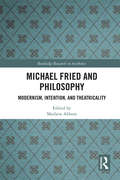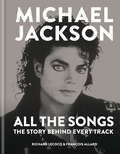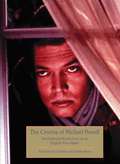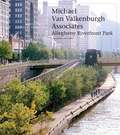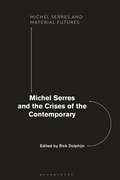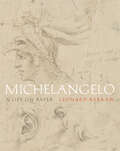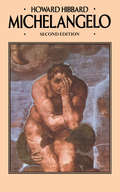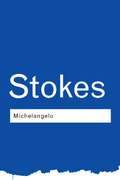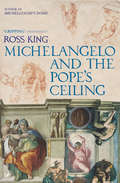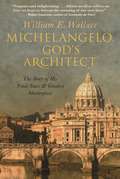- Table View
- List View
Michael Fried and Philosophy: Modernism, Intention, and Theatricality (Routledge Research in Aesthetics)
by Mathew AbbottThis volume brings philosophers, art historians, intellectual historians, and literary scholars together to argue for the philosophical significance of Michael Fried’s art history and criticism. It demonstrates that Fried’s work on modernism, artistic intention, the ontology of art, theatricality, and anti-theatricality can throw new light on problems in and beyond philosophical aesthetics. Featuring an essay by Fried and articles from world-leading scholars, this collection engages with philosophical themes from Fried’s texts, and clarifies the relevance to his work of philosophers such as Ludwig Wittgenstein, Stanley Cavell, Morris Weitz, Elizabeth Anscombe, Arthur Danto, George Dickie, Immanuel Kant, Friedrich Schiller, G. W. F. Hegel, Arthur Schopenhauer, Friedrich Nietzsche, Denis Diderot, Maurice Merleau-Ponty, Roland Barthes, Jacques Rancière, and Søren Kierkegaard. As it makes a case for the importance of Fried for philosophy, this volume contributes to current debates in analytic and continental aesthetics, philosophy of action, philosophy of history, political philosophy, modernism studies, literary studies, and art theory.
Michael Fried and Philosophy: Modernism, Intention, and Theatricality (Routledge Research in Aesthetics)
by Mathew AbbottThis volume brings philosophers, art historians, intellectual historians, and literary scholars together to argue for the philosophical significance of Michael Fried’s art history and criticism. It demonstrates that Fried’s work on modernism, artistic intention, the ontology of art, theatricality, and anti-theatricality can throw new light on problems in and beyond philosophical aesthetics. Featuring an essay by Fried and articles from world-leading scholars, this collection engages with philosophical themes from Fried’s texts, and clarifies the relevance to his work of philosophers such as Ludwig Wittgenstein, Stanley Cavell, Morris Weitz, Elizabeth Anscombe, Arthur Danto, George Dickie, Immanuel Kant, Friedrich Schiller, G. W. F. Hegel, Arthur Schopenhauer, Friedrich Nietzsche, Denis Diderot, Maurice Merleau-Ponty, Roland Barthes, Jacques Rancière, and Søren Kierkegaard. As it makes a case for the importance of Fried for philosophy, this volume contributes to current debates in analytic and continental aesthetics, philosophy of action, philosophy of history, political philosophy, modernism studies, literary studies, and art theory.
Michael Haneke's Cinema: The Ethic of the Image (Film Europa #7)
by Catherine WheatleyExisting critical traditions fail to fully account for the impact of Austrian director, and 2009 Cannes Palm d'Or winner, Michael Haneke’s films, situated as they are between intellectual projects and popular entertainments. In this first English-language introduction to, and critical analysis of, his work, each of Haneke’s eight feature films are considered in detail. Particular attention is given to what the author terms Michael Haneke’s ‘ethical cinema’ and the unique impact of these films upon their audiences. Drawing on the moral philosophy of Immanuel Kant and Stanley Cavell, Catherine Wheatley, introduces a new way of marrying film and moral philosophy, which explicitly examines the ethics of the film viewing experience. Haneke’s films offer the viewer great freedom whilst simultaneously imposing a considerable burden of responsibility. How Haneke achieves this break with more conventional spectatorship models, and what its far-reaching implications are for film theory in general, constitute the principal subject of this book.
Michael Jackson: The Story Behind Every Track
by François Allard Richard LecocqPlease note: this edition is text only and does not contain images.This is the full story of every single song that Michael Jackson recorded and released during his long and remarkable solo career.With fascinating stories and detailed information on every track - as well as key early songs with The Jackson Five and his legendary dance moves and videos - All the Songs is the complete history of one of the greatest musical legacies of all time.Arranged chronologically by album, expert authors Lecocq and Allard explore the details behind early hits such as ABC and I Want You Back, to solo masterpieces such as Don't Stop 'Til You Get Enough, Billie Jean, Beat It, Smooth Criminal, Black or White, This Is It and more - including outtakes, duets and rare tracks.Explore the magic behind the King of Pop's music with this in-depth, captivating book.
Michael Mann: Kino zwischen Zorn und Einsamkeit
by Holger SchumacherZum ersten Mal widmen sich zehn deutschsprachige Wissenschaftler mit unterschiedlichen Forschungsschwerpunkten dem Gesamtwerk Michael Manns. Dabei werden die Leser*innen zu einer zweifachen Reise eingeladen: Auf einem faszinierenden Tauchgang in die Filmwelt des gefeierten Regisseurs treten zentrale Themen, Figurenkonstellationen, kulturelle Hintergründe und Wirkungseinheiten zutage, die einen völlig neuen Blick auf seine Kunst eröffnen: Wie schafft es Michael Mann seit mehr als 40 Jahren, ein weltweites Publikum zu fesseln und immer wieder aufs Neue in den Kinosaal zu locken? Was verraten seine Filme dadurch über die unbewussten Sehnsüchte, Obsessionen und Widerstände in unserer Kultur? Gleichzeitig entwickelt sich ein spannender Dialog zwischen den verschiedenen Deutungsansätzen: Anhand populärer Kinofilme wie HEAT oder COLLATERAL wecken die wichtigsten Disziplinen - von der Morphologie bis zur Seduktionstheorie - Neugier auf den Facettenreichtum der deutschsprachigen Filmwissenschaft. Auf diese Weise entsteht ein Buch über die Kunst des Films und seiner Interpretation.
Michael Powell: International Perspectives on an English Film-maker
by Ian Christie Andrew MoorThe films of Michael Powell (1905-90) and Emeric Pressburger (1902-88), among them I Know Where I'm Going! (1945), A Matter of Life and Death (1947) and The Red Shoes (1948), are landmarks in British cinema, standing apart from the realist and comic mainstream with their highly stylised aesthetic and their themes of romantic longing and spiritual crisis. Powell and Pressburger are revered by film lovers and film-makers (Martin Scorsese has called them 'the most successful experimental film-makers in the world'). In this first-ever collection of essays on Powell, an international group of critics and scholars map out his film-making skills, providing new readings of individual films, analysing recurrent techniques and themes, and relating them to contemporary debates about gender, sexuality, nationality and cinematic spectacle. Powell, with and without Pressburger, emerges as a film-maker of lasting originality and significance.
Michael Powell: International Perspectives on an English Film-maker
The films of Michael Powell (1905-90) and Emeric Pressburger (1902-88), among them I Know Where I'm Going! (1945), A Matter of Life and Death (1947) and The Red Shoes (1948), are landmarks in British cinema, standing apart from the realist and comic mainstream with their highly stylised aesthetic and their themes of romantic longing and spiritual crisis. Powell and Pressburger are revered by film lovers and film-makers (Martin Scorsese has called them 'the most successful experimental film-makers in the world'). In this first-ever collection of essays on Powell, an international group of critics and scholars map out his film-making skills, providing new readings of individual films, analysing recurrent techniques and themes, and relating them to contemporary debates about gender, sexuality, nationality and cinematic spectacle. Powell, with and without Pressburger, emerges as a film-maker of lasting originality and significance.
Michael Van Valkenburgh Associates: Allegheny Riverfront Park (Source Books in Landscape Architecture #1)
by Jane AmidonIn the field of landscape architecture, there is no more distinguished voice than Michael Van Valkenburgh, and it therefore seems appropriate that we begin this new Source Books in Landscape series with his recently completed Allegheny Riverfront Park project for Pittsburgh, Pennsylvania. As part of the city’s efforts to restore its downtown district and riverfront, Van Valkenburgh, along with artists Ann Hamilton and Michael Mercil, developed an ambitious plan to reform the wasted land along the river into an urban refuge. The celebrated collaboration between landscape architect and artist produced a thoughtful, useful, and beautiful park that has successfully renewed the city’s core. Source Books in Landscape Architecture, produced in collaboration with Ohio State University, will provide detailed documentation of important new projects, following its development from conception through completion using sketches, drawings, models, renderings, working drawings, and photographs.
Michael Winner: A Life Of Sorts
by Michael WinnerMichael Winner, the legendary film director, writer and food critic, is a colourful figure who has led a remarkable life. He has a reputation for being outspoken, and, true to form, in his autobiography he tells it like it is with sharp and insightful observations.
Michael Winterbottom (British Film-Makers)
by Brian McFarlane Deane WilliamsThis is the first book-length study of the most prolific and most critically acclaimed director working in British cinema today. Michael Winterbottom has also established himself, and his company, Revolution Films, as a dynamic force in world cinema. No other British director can claim such an impressive body of work in such a variety of genres, from road movie to literary adaptation, from musical to sex film, to stories of contemporary political significance. The authors of this book use a range of critical approaches to analyse the filmmaker’s eclectic interests in cinema and the world at large. With this in mind, the realist elements of such films as Welcome to Sarajevo are examined in the light of a long history of cinema’s dealings with realism, as far back as post-war Italian neo-realist filmmaking; whereas Jude and The claim are approached as both literary adaptations (a continuing strand in British cinema history) and examples of other reworked genres (the road movie, the western).This lively study of his work, written in a wholly accessible style, will engage all those who have followed his career as well as those with a wide-ranging interest in British cinema.
Michel Serres and the Crises of the Contemporary (Michel Serres and Material Futures)
by Rick DolphijnMichel Serres captures the urgencies of our time; from the digital revolution to the ecological crisis to the future of the university, the crises that code the world today are addressed in an accessible, affirmative and remarkably original analysis in his thought.This volume is the first to engage with the philosophy of Michel Serres, not by writing 'about' it, but by writing 'with' it. This is done by expanding upon the urgent themes that Serres works on; by furthering his materialism, his emphasis on communication and information, his focus on the senses, and the role of mathematics in thought. His famous concepts, such as the parasite, 'amis de viellesse', and the algorithm are applied in 21st century situations. With contributions from an international and interdisciplinary team of authors, these writings tackle the crises of today and affirm the contemporary relevance of Serres' philosophy.
Michel Serres and the Crises of the Contemporary (Michel Serres and Material Futures)
by Rick DolphijnMichel Serres captures the urgencies of our time; from the digital revolution to the ecological crisis to the future of the university, the crises that code the world today are addressed in an accessible, affirmative and remarkably original analysis in his thought.This volume is the first to engage with the philosophy of Michel Serres, not by writing 'about' it, but by writing 'with' it. This is done by expanding upon the urgent themes that Serres works on; by furthering his materialism, his emphasis on communication and information, his focus on the senses, and the role of mathematics in thought. His famous concepts, such as the parasite, 'amis de viellesse', and the algorithm are applied in 21st century situations. With contributions from an international and interdisciplinary team of authors, these writings tackle the crises of today and affirm the contemporary relevance of Serres' philosophy.
Michelangelo: A Life on Paper
by Leonard BarkanA groundbreaking account of the role of writing in Michelangelo's artMichelangelo is best known for great artistic achievements such as the Sistine ceiling, the David, the Pietà, and the dome of St. Peter's. Yet throughout his seventy-five year career, he was engaged in another artistic act that until now has been largely overlooked: he not only filled hundreds of sheets of paper with exquisite drawings, sketches, and doodles, but also, on fully a third of these sheets, composed his own words. Here we can read the artist's marginal notes to his most enduring masterpieces; workaday memos to assistants and pupils; poetry and letters; and achingly personal expressions of ambition and despair surely meant for nobody's eyes but his own. Michelangelo: A Life on Paper is the first book to examine this intriguing interplay of words and images, providing insight into his life and work as never before.This sumptuous volume brings together more than two hundred stunning, museum-quality reproductions of Michelangelo's most private papers, many in color. Accompanying them is Leonard Barkan's vivid narrative, which explains the important role the written word played in the artist's monumental public output. What emerges is a wealth of startling juxtapositions: perfectly inscribed sonnets and tantalizing fragments, such as "Have patience, love me, sufficient consolation"; careful notations listing money spent for chickens, oxen, and funeral rites for the artist's father; a beautiful drawing of a Madonna and child next to a mock love poem that begins, "You have a face sweeter than boiled grape juice, and a snail seems to have passed over it." Magnificently illustrated and superbly detailed, this book provides a rare and intimate look at how Michelangelo's artistic genius expressed itself in words as well as pictures.
Michelangelo: A Tormented Life
by Antonio ForcellinoThis major new biography recounts the extraordinary life of one of the most creative figures in Western culture, weaving together the multiple threads of Michelangelo’s life and times with a brilliant analysis of his greatest works. The author retraces Michelangelo’s journey from Rome to Florence, explores his changing religious views and examines the politics of patronage in Renaissance Italy, politics that were complicated by the fact that Michelangelo worked for both the Medici and the Papacy. He discusses Michelangelo’s character in detail, showing him to be a tormented man, solitary, avaricious, deeply religious, burdened with repressed homosexuality and a surplus of creative enthusiasm. Drawing on Michelangelo’s memoirs and personal correspondence, the author paints a portrait of a deeply contradictory man whose work was infused with a sensuality of which he chose to deprive himself. For the first time, Forcellino explores the spiritual turning point Michelangelo experienced between the late 1530s and the early 1540s, a crucial period when he created some of his most important works, such as the Universal Judgement and Moses. Forcellino offers a systematic reconstruction and interpretation of the frescos in the Paolina Chapel which Michelangelo completed in the late 1540s. Although less well-known than their counterparts in the Sistine Chapel, Forcellino shows that these frescos are among the artist’s supreme achievements. The author also seeks to reconstruct the last years of Michelangelo’s life, dark years of which we know very little but which are fundamental to the posthumous creation of the Michelangelo legend. As a restorer and a recognized expert on Michelangelo, Forcellino took part in the restoration of the Sistine Chapel and Moses, two projects which gave us a new perspective on the techniques used by Michelangelo, the way he worked with colour and marble and the tools he used.
Michelangelo: His Epic Life
by Martin GayfordAt thirty one, Michelangelo was considered the finest artist in Italy, perhaps the world; long before he died at almost 90 he was widely believed to be the greatest sculptor or painter who had ever lived (and, by his enemies, to be an arrogant, uncouth, swindling miser).For decade after decade, he worked near the dynamic centre of events: the vortex at which European history was changing from Renaissance to Counter Reformation. Few of his works - including the huge frescoes of the Sistine Chapel Ceiling, the marble giant David and the Last Judgment - were small or easy to accomplish. Like a hero of classical mythology - such as Hercules, whose statue he carved in his youth - he was subject to constant trials and labours.In Michelangelo Martin Gayford describes what it felt like to be Michelangelo Buonarroti, and how he transformed forever our notion of what an artist could be.
Michelangelo
by Howard HibbardIn this masterly, Howard Hibbard relates Michelangelo's art to his life and to the times in which he lived, relying on the earliest biographies and the latest scholarly research as well as on Michelangelo's own letters and poems. What emerges is both a perspective appraisal of his work and a revealing life history of the man who was arguably the greatest artist of all time.
Michelangelo (Pelican Ser.)
by Howard HibbardIn this masterly, Howard Hibbard relates Michelangelo's art to his life and to the times in which he lived, relying on the earliest biographies and the latest scholarly research as well as on Michelangelo's own letters and poems. What emerges is both a perspective appraisal of his work and a revealing life history of the man who was arguably the greatest artist of all time.
Michelangelo
by Adrian StokesAdrian Stokes was one of the twentieth century's finest and most discriminating writers on art. Of over twenty works of art criticism, Michelangelo was considered by Lawrence Gowing to be the most complete he ever wrote, presenting an understanding of the great artist that no one subsequently could afford to ignore. Stokes brings to bear in this work not only twenty-five years' study and appreciation of Italian Renaissance art and of aesthetics, but also a unique psychological perspective, as he explains in his introduction, which enables him to uncover the depths of the artist's personality. The subtlety of feeling and profound knowledge of sculpture which Sir Herbert Read admired in Stokes's work is also combined with a literary style perfected through his own poetry and criticism. Presenting a unique survey of his subject's literary as well as his artistic legacy, Stokes succeeds, as no other has before or since, in his aim of bringing Michelangelo's greatness into nearer view.
Michelangelo
by Adrian StokesAdrian Stokes was one of the twentieth century's finest and most discriminating writers on art. Of over twenty works of art criticism, Michelangelo was considered by Lawrence Gowing to be the most complete he ever wrote, presenting an understanding of the great artist that no one subsequently could afford to ignore. Stokes brings to bear in this work not only twenty-five years' study and appreciation of Italian Renaissance art and of aesthetics, but also a unique psychological perspective, as he explains in his introduction, which enables him to uncover the depths of the artist's personality. The subtlety of feeling and profound knowledge of sculpture which Sir Herbert Read admired in Stokes's work is also combined with a literary style perfected through his own poetry and criticism. Presenting a unique survey of his subject's literary as well as his artistic legacy, Stokes succeeds, as no other has before or since, in his aim of bringing Michelangelo's greatness into nearer view.
Michelangelo And The Pope's Ceiling
by Ross KingIn 1508, Pope Julius II commissioned Michelangelo to paint the ceiling of the Sistine Chapel. The thirty-three-year-old Michelangelo had very little experience of the physically and technically taxing art of fresco; and, at twelve thousand square feet, the ceiling represented one of the largest such projects ever attempted. Nevertheless, for the next four years he and a hand-picked team of assistants laboured over the vast ceiling, making thousands of drawings and spending back-breaking hours on a scaffold fifty feet above the floor. The result was one of the greatest masterpieces of all time. This fascinating book tells the story of those four extraordinary years and paints a magnificent picture of day-to-day life on the Sistine scaffolding - and outside, in the upheaval of early sixteenth-century Rome.
Michelangelo and the Pope's Ceiling
by Ross KingFrom the acclaimed author of Brunelleschi's Dome and Leonardo and the Last Supper, the riveting story of how Michelangelo, against all odds, created the masterpiece that has ever since adorned the ceiling of the Sistine Chapel.In 1508, despite strong advice to the contrary, the powerful Pope Julius II commissioned Michelangelo Buonarroti to paint the ceiling of the newly restored Sistine Chapel in Rome. Despite having completed his masterful statue David four years earlier, he had little experience as a painter, even less working in the delicate medium of fresco, and none with challenging curved surfaces such as the Sistine ceiling's vaults. The temperamental Michelangelo was himself reluctant: He stormed away from Rome, incurring Julius's wrath, before he was eventually persuaded to begin. Michelangelo and the Pope's Ceiling recounts the fascinating story of the four extraordinary years he spent laboring over the twelve thousand square feet of the vast ceiling, while war and the power politics and personal rivalries that abounded in Rome swirled around him. A panorama of illustrious figures intersected during this time-the brilliant young painter Raphael, with whom Michelangelo formed a rivalry; the fiery preacher Girolamo Savonarola and the great Dutch scholar Desiderius Erasmus; a youthful Martin Luther, who made his only trip to Rome at this time and was disgusted by the corruption all around him.Ross King blends these figures into a magnificent tapestry of day-to-day life on the ingenious Sistine scaffolding and outside in the upheaval of early-sixteenth-century Italy, while also offering uncommon insight into the connection between art and history.
Michelangelo, God's Architect: The Story of His Final Years and Greatest Masterpiece
by William E. WallaceThe untold story of Michelangelo's final decades—and his transformation into one of the greatest architects of the Italian RenaissanceAs he entered his seventies, the great Italian Renaissance artist Michelangelo despaired that his productive years were past. Anguished by the death of friends and discouraged by the loss of commissions to younger artists, this supreme painter and sculptor began carving his own tomb. It was at this unlikely moment that fate intervened to task Michelangelo with the most ambitious and daunting project of his long creative life.Michelangelo, God's Architect is the first book to tell the full story of Michelangelo's final two decades, when the peerless artist refashioned himself into the master architect of St. Peter’s Basilica and other major buildings. When the Pope handed Michelangelo control of the St. Peter’s project in 1546, it was a study in architectural mismanagement, plagued by flawed design and faulty engineering. Assessing the situation with his uncompromising eye and razor-sharp intellect, Michelangelo overcame the furious resistance of Church officials to persuade the Pope that it was time to start over.In this richly illustrated book, leading Michelangelo expert William Wallace sheds new light on this least familiar part of Michelangelo’s biography, revealing a creative genius who was also a skilled engineer and enterprising businessman. The challenge of building St. Peter’s deepened Michelangelo’s faith, Wallace shows. Fighting the intrigues of Church politics and his own declining health, Michelangelo became convinced that he was destined to build the largest and most magnificent church ever conceived. And he was determined to live long enough that no other architect could alter his design.
Michelangelo - Old man wearing a hat (Philosopher)
by RnibThis drawing is by Michelangelo about 495-1500 is pen and two shades of brown ink on paper. It is a full-length side view of an old man who is facing to the right. He is wearing a long robe that covers his whole body apart from his forearms, hands and left foot. The robe is shown with many folds as it contains a great deal of fabric. Michelangelo's interest seems to be on expressing volume, thus every fold and shadow of the man's drapery is defined with an interlocking network of tiny lines. His face and long beard are shown beneath a peaked hat. The peaked hat has a shell on its side, between the brim and the crown. The old man's forearms and hands are shown coming out from beneath the deep folds of the arms of the robe. He is holding a slightly rounded object in his hands that, as stated above, is either a skull or casket. The tactile image is very slightly smaller than the original drawing and shows an outline of the figure defined by thick lines. Thin lines and two different textures have been used to give an idea of the folds of the robe. Solid texture has been used to show the peaked hat, forearms, the rounded object held in the hands and the left foot. The shell is shown as a hollow in the solid texture of the hat.
Michelangelo und das Problem der Säkularisation: 155. Sitzung am 21. Januar 1970 in Düsseldorf (Rheinisch-Westfälische Akademie der Wissenschaften #G 181)
by Georg KauffmannMichelangelo - Youth beckoning, a right leg (recto) (SEB)
by RnibThis drawing by Michelangelo (1475-1564) completed about 1504 is pen and brown ink (figure), black chalk (leg) on paper. The drawing shows the front view of a naked man standing on his right leg with his left leg raised off the floor slightly behind him. His body is facing the viewer with his head turned to the viewer's right. He is looking towards his left arm that is slightly bent at the elbow and raised up above his head, with the hand disappearing off the paper in the top right-hand corner. The drawing concentrates on the torso, head and left arm. The man's right arm has not been drawn in enough detail to clearly see its position apart from a hint with sketchy lines that it would have been down by his side. Both legs are also shown with sketchy lines but they are strong enough to understand the leg positions. No feet have been shown. Shading and lines on the torso show the firm muscle structure with nipples, hollow for belly button and genitals clearly drawn. The head is topped by a series of wavy lines that represent the youth's hair. The facial features - eyes, nose and mouth - are indicated mainly by shading. The tactile image is slightly smaller than the original drawing. It shows the outline of the drawing in a thick line with a texture for the main areas of shading and thinner lines for the lines on the torso. Very thin lines show the sketchy lines on the legs and right arm.
